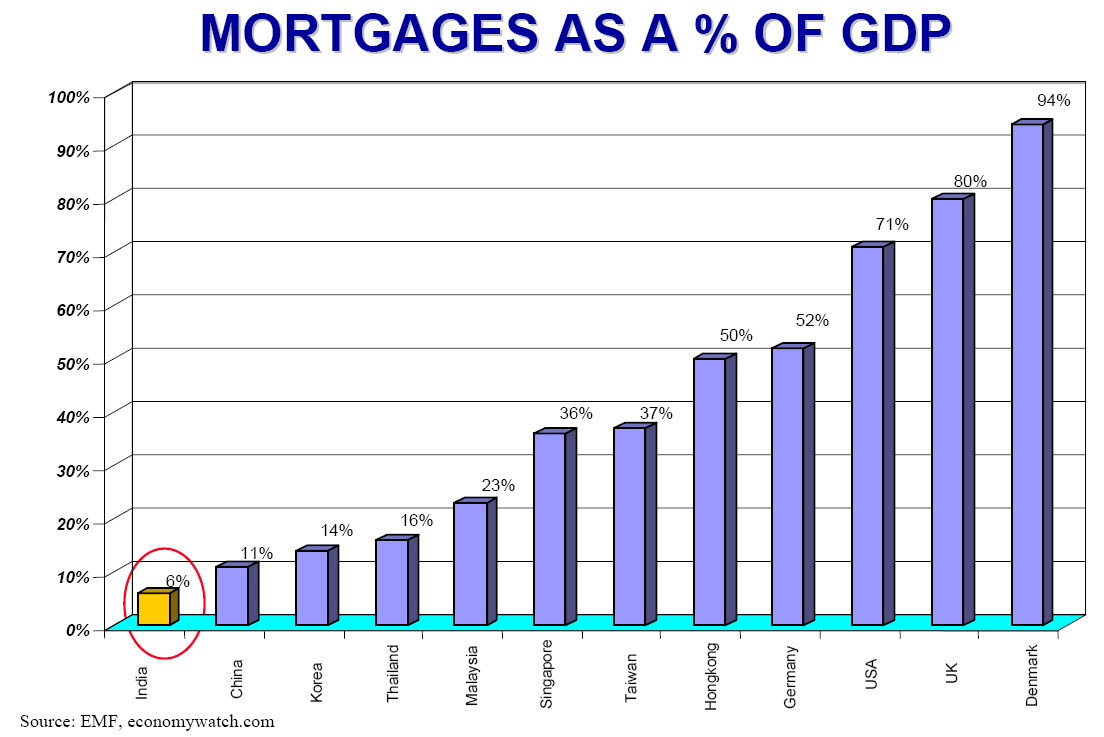Kuroto Fund, L.P. - Q2 2007 Letter
Dear Partners and Friends,
Mortgage Lending in India and America
Approximately one third of Kuroto Fund’s capital is currently invested in financial businesses. Our willingness to hold such a sizable position in financials is, in large part, a result of the chastening effect that the Asia Crisis has had on the region’s borrowers and lenders. With the notable exception of China, a general wariness concerning the creation of new non-performing assets remains apparent throughout the region. This wariness stands in sharp contrast to the lack of caution which America’s financial system has displayed in recent years. Nowhere, perhaps, is the contrast between American financial laxity and Asian financial conservatism more apparent than in the comparison of India’s and America’s mortgage markets.
Not only is India’s mortgage debt to GDP less than one tenth of the same ratio in the US, but the Indian financial system is regulated by a central bank with a willingness to preempt excessive credit growth and a healthy skepticism of gain on sale accounting. In fact, the Reserve Bank of India does not permit any up-front recognition of gains resulting from securitization. All such revenue must be recognized over the life of a securitized trust. Contrast this with the accounting convention in America that still allows mortgage originators to book a decade’s worth of revenue on the day a mortgage is securitized. Gain on sale accounting is but one example of an unsound practice that is widely employed in America but never really permitted in India. When combined with India’s low mortgage penetration rate, India’s more stringent regulatory environment has helped ensure its financial system’s continued health in a time of credit market turmoil.
Counterparty Risk
The most troublesome variety of counterparty risk invariably originates with a firm of superior reputation. Long-Term Capital Management (LTCM) is a perfect example. Investors and counterparties alike, awed by LTCM's principals, failed to ask tough questions and thereby permitted the leverage that made LTCM’s eventual collapse so spectacular. In the nine years since LTCM’s demise, no hedge fund, no matter how lofty the reputation of its principals, has been able to escape the careful scrutiny of its counterparties. The market is simply too well schooled in hedge fund fragility. On account of the caution with which counterparties now treat hedge funds, we would be surprised if hedge funds, even highly levered ones, are at the center of the next big counterparty problem. We suspect that the truly problematic counterparty risk is lurking elsewhere in the financial system, somewhere with opaque balance sheets, aggressive leverage, and the arrogance and reputation to avoid answering tough, pointed questions. Our candidate is the investment banks.
The opacity of these firms is easily observable. One needs only to download a 10-K and dig in, footnotes first. Even if you are familiar with the alphabet soup of financial entity accounting, which is to say that you know your VIEs from your QSPEs and have a firm grasp on SFAS157, you’ll find a lot of information but not the information you need to judge these firms’ credit worthiness. In May of this year, at the end of a long conversation spent reviewing a particular investment bank’s footnotes, the company representative with whom we were speaking conceded what we’d already concluded: that the net exposure to various asset classes could not be deduced from the material provided. No amount of financial statement analysis would tell us what net exposure this particular investment bank had to structured product residuals, high yield debt, or bridge financing. The information simply wasn’t there. We were left, in the words of this company representative, to trust the firm’s strong culture, a shockingly arrogant comment from such a highly levered financial firm.
If, as we suspect, investment banks do pose a significant risk to their counterparties, many of whom are hedge funds, this is indeed a great irony, as the current thinking is that hedge fund failures pose a risk to investment banks, not visa versa. Other managers with whom we’ve spoken about this issue are largely dismissive of the potential risk. Were a major investment bank to become insolvent, they reason, the shareholders and maybe even general creditors would be punished, but the government would step in to protect the clients and other counterparties. The alternative is simply too catastrophic to countenance. Even we will admit that given the Fed’s track record of intervention over the past two decades, the US government could be seen as having had guaranteed the performance of the major investment banks as counterparties. Even so, we see no reason to test this guarantee.
Kuroto Fund has long taken a deliberate approach to counterparty risk management, carefully analyzing prospective counterparties and choosing to distribute our exposure across several firms if none stands out as a materially better risk. This past quarter, we took the additional step of segregating our custody assets from our prime brokerage assets. As we employ only modest amounts of leverage, we've been able to move a meaningful fraction of our long securities into a ring-fenced bank custody account at Northern Trust. While no account is completely free of counterparty risk, this, we believe, is as close as it comes. To the extent that we sell short and invest on margin, we will continue to hold a portion of our portfolio at Goldman Sachs and UBS. That said, the fund’s counterparty risk is now limited to a minimum given the portfolio structure.
Sincerely,
Sean Fieler
William W. Strong










